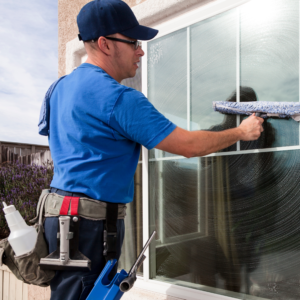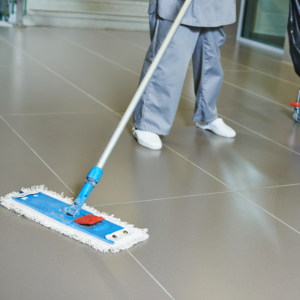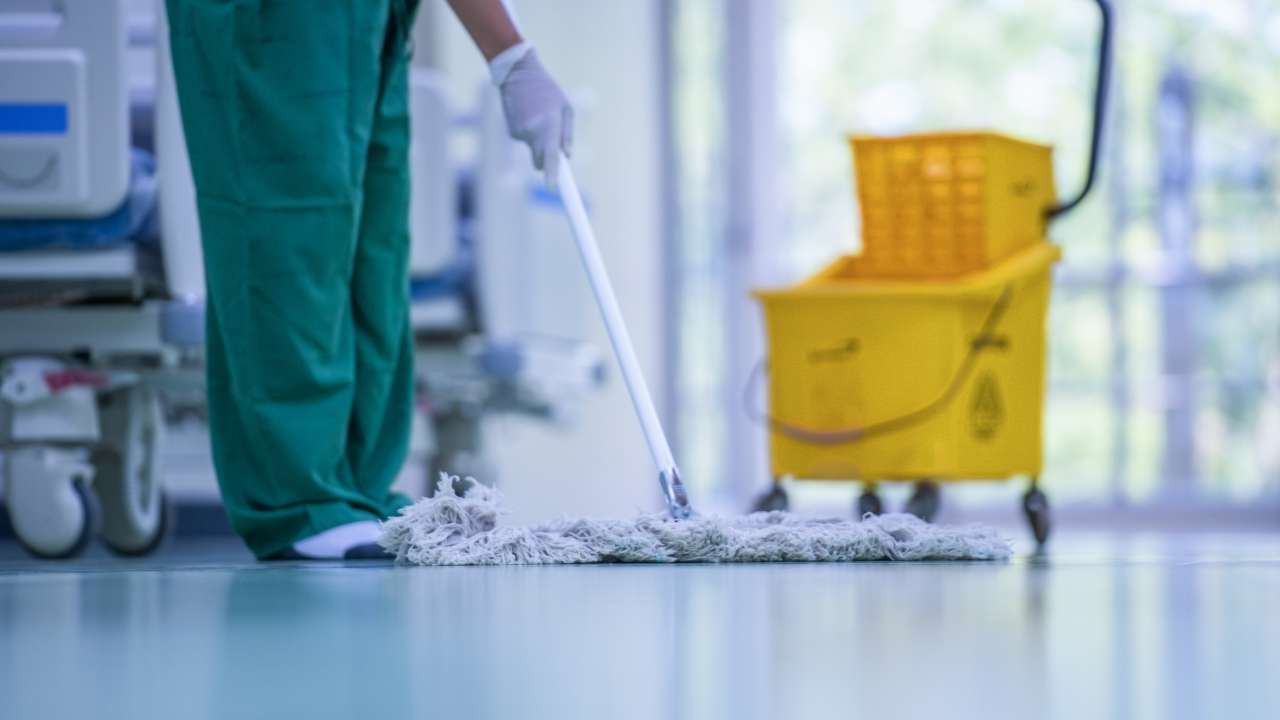For patients seeking medical care, the quality of services goes beyond just clinical skills and treatment plans. The environment plays a crucial role in shaping their entire experience, impacting not only their perceptions of a facility but also their recovery outcomes. In this realm, commercial cleaning emerges as an often-overlooked yet critical factor contributing to patient satisfaction in medical facilities.
American Facility Care understands the profound connection between hygiene and patient well-being. As a trusted cleaning partner in Indianapolis and its surrounding areas, we’ve witnessed firsthand the transformative power of professional cleaning practices in fostering a comfortable, safe, and healing environment.
This post dives deep into the intricate links between commercial cleaning and patient satisfaction in medical facilities. We’ll explore the tangible benefits of a pristine environment, unveil potential pitfalls of improper cleaning, and offer insights into optimizing your cleaning protocols for maximized patient satisfaction.
Why Cleanliness Matters in Medical Facilities
Stepping into a medical facility, patients are inherently vulnerable. Anxiety, discomfort, and even fear are often at play. In such a sensitive context, cleanliness takes on a new dimension, transcending mere aesthetics and becoming essential for ensuring their well-being.
- Hygiene and Infection Control:
Medical facilities are breeding grounds for pathogens. Ineffective cleaning practices can lead to the accumulation and spread of harmful bacteria, viruses, and fungi, increasing the risk of healthcare-associated infections (HAIs). HAIs not only threaten patient safety but also burden healthcare systems with extended hospital stays and escalating costs. Thorough and meticulous cleaning, as per CDC guidelines, significantly reduces the risk of HAIs, fostering a safer environment for both patients and staff.
- Building Trust and Confidence:
A clean and well-maintained environment sends a powerful message to patients – one of care, professionalism, and commitment to their well-being. Visible dirt, dust, or grime, on the other hand, can paint a picture of negligence and indifference, eroding trust and potentially compromising patient confidence in the facility’s ability to deliver quality care.
- Enhancing Comfort and Reducing Anxiety:
Medical environments can be inherently stressful. A pristine, orderly space can contribute significantly to alleviating anxiety and promoting a sense of calmness. Imagine the difference between waiting in a dimly lit room with overflowing wastebaskets and stained upholstery, versus a bright, airy space with sanitized surfaces and comfortable seating. The latter undoubtedly fosters a more positive and reassuring experience for patients.
- Promoting Healing and Recovery:
A clean environment not only prevents infections but also improves the healing process. Studies have shown that patients recovering in clean rooms experience reduced pain, shorter hospital stays, and better overall outcomes. This is attributed to the reduced stress and anxiety that comes with being in a hygienic space.
Potential Pitfalls of Inadequate Cleaning in Medical Facilities
While the benefits of effective cleaning are undeniable, neglecting this crucial aspect can have serious consequences for both patients and the facility itself.
- Increased Risk of HAIs:
As mentioned earlier, inadequate cleaning practices directly contribute to the proliferation of pathogens, leading to higher rates of HAIs. Apart from compromising patient safety, this translates to longer hospital stays, increased costs, and potential legal ramifications for the facility.
- Damage to Reputation and Brand Image:
Word-of-mouth, online reviews, and social media play a significant role in shaping public perception of healthcare facilities. Patients dissatisfied with cleanliness are likely to share their negative experiences, damaging the facility’s reputation and deterring potential future patients.
- Decreased Staff Morale and Productivity:
Working in an unsanitary environment can be demotivating for staff. Feeling like their efforts are undermined by poor cleaning practices can affect their morale and productivity, potentially impacting the overall quality of care delivered.
Optimizing Your Cleaning Protocols for Maximum Patient Satisfaction
Now that we’ve established the critical link between commercial cleaning and patient satisfaction, let’s delve into practical ways to optimize your cleaning protocols for maximum impact.
Partner with a Reputable Commercial Cleaning Provider
Maintaining a consistently high standard of cleanliness in a medical facility requires expertise, resources, and a commitment to quality. This is where partnering with a reputable commercial cleaning provider like American Facility Care becomes invaluable.
We understand the unique demands and challenges of healthcare environments. Our team of trained and certified cleaning professionals are equipped with the knowledge, experience, and specialized equipment to ensure thorough and meticulous cleaning that adheres to the strictest hygiene standards.
Benefits of partnering with AFC:
- Customized Cleaning Plans: We tailor cleaning protocols to your specific facility type, patient population, and areas of concern.
- Infection Prevention Expertise: Our team is well-versed in CDC guidelines and best practices for preventing the spread of pathogens.
- Advanced Cleaning Technologies: We utilize cutting-edge cleaning equipment and disinfectants to ensure optimal hygiene.
- Flexible Scheduling and Reporting: We work around your schedule and provide detailed cleaning reports for transparency and accountability.
Implement a Comprehensive Cleaning Protocol
Developing a standardized and comprehensive cleaning protocol is crucial for ensuring consistency and effectiveness. This protocol should address all areas of the facility, from patient rooms and waiting areas to restrooms and staff breakrooms.
Key elements of a comprehensive cleaning protocol:
- Frequency of cleaning: Establish clear schedules for cleaning different areas based on their level of traffic and potential for contamination.
- Specific cleaning procedures: Define the specific steps and techniques for cleaning different surfaces, equipment, and fixtures.
- Disinfection procedures: Outline the proper use of disinfectants to eliminate pathogens and prevent the spread of infections.
- Waste management: Implement proper procedures for handling and disposing of medical waste to minimize contamination risks.
Focus on High-Touch Areas

Certain surfaces within a medical facility are at higher risk for harboring pathogens due to frequent contact.
These high-touch areas require particular attention during cleaning procedures.
Examples of high-touch areas:
- Doorknobs and handles
- Light switches and buttons
- Patient bed rails and overbed tables
- Chairs and seating surfaces
- Bathroom fixtures and countertops
- Medical equipment and instruments
Prioritize Patient Comfort and Experience
While adhering to strict hygiene protocols is essential, it’s equally important to consider the patient experience during cleaning procedures. Here are some tips:
- Minimize noise and disruption: Schedule cleaning activities during periods of low patient activity or utilize quiet cleaning equipment.
- Use odorless or lightly scented cleaning products: Avoid strong fragrances that might be unpleasant for patients.
- Maintain a clean and organized appearance: Ensure cleaning supplies are stored out of sight and surfaces are free of clutter.
- Communicate with patients: Inform them about cleaning schedules and procedures to manage expectations and minimize anxiety.
Continuously Monitor and Improve
Maintaining optimal cleaning standards requires ongoing monitoring and evaluation. Regularly track your cleaning performance through:
- Environmental testing: Periodically test surfaces for the presence of pathogens to ensure disinfection protocols are effective.
- Patient satisfaction surveys: Gather feedback from patients to understand their perceptions of cleanliness and identify areas for improvement.
- Staff feedback: Encourage open communication with cleaning staff to identify any challenges they face and ensure they have the resources and training needed to perform their jobs effectively.
By proactively monitoring and continuously improving your cleaning protocols, you can create a cleaner, safer, and more patient-centered environment, ultimately leading to increased patient satisfaction and a positive reputation for your healthcare facility.
Investing in professional cleaning is not merely an operational expense but a strategic investment in patient safety, satisfaction, and the overall success of your healthcare facility. By partnering with AFC, you can ensure your medical facility performing at its highest potential. Reach out today for a free consultation!

Tom Moore has been a part of the commercial cleaning and facility management industry since 2005. He co-founded American Facility Care in 2014 with the idea of bringing safety and aesthetics to buildings across central Indiana. He has an APIC certification in Infection Control and Prevention, and enjoys passing that knowledge on to his team using their exclusive Hygienic Training Method of cleaning. Tom co-hosts The Cleaning Indy Podcast, and would love a chance to connect with you and perhaps have you as a guest of the show.







